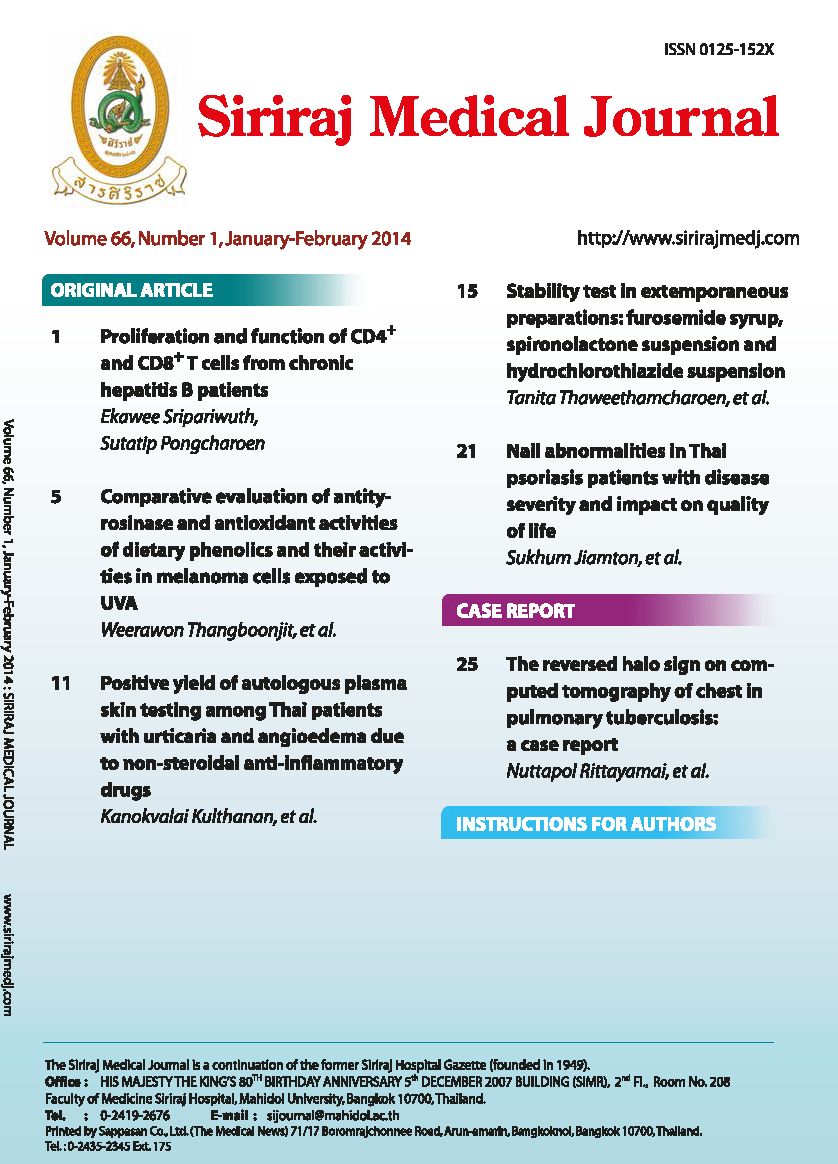Positive Yield of Autologous Plasma Skin Testing among Thai Patients with Urticaria and Angioedema due to Non-steroidal Anti-inflammatory Drugs
Abstract
Background: Non-steroidal anti-inflammatory drugs (NSAIDs) are over-the-counter drugs which are widely used. In Thailand, cutaneous reactions to nonsteroidal anti-inflammatory drugs were frequently angioedema and urticaria. However, there are many limitations of the diagnostic investigations, so the diagnosis is still based on history and clinical manifestation. In 2007, there was a study in Italy, which reported that an autologous plasma skin test (APST) could detect autoreactive state in patients with multiple intolerances to NSAIDs.
Objective: We aimed to investigate whether APST is positive in single and multiple NSAID reactors in the Thai population or not.
Methods: The patients with recent history of urticaria and/or angioedema following the administration of NSAIDs were prospectively recruited. Individuals were classified into two groups (single or multiple NSAID reactors) based on history, clinical manifestation and/or laboratory investigation and then APST was done after at least a month free of symptoms.
Results: Of all sixty-eight patients, thirteen (19.1%) were men and fifty-five (80.9%) were women. The mean age was 42.7 ± 15.0 years (range 17-77 years). In our study, single NSAID reactors (69.1%) were more common than multiple NSAID reactors (30.9%). Multiple NSAID reactors tended to have a personal and family history of atopy (p = 0.030 and 0.012, respectively) than single reactors. APST was positive 19.0% and 10.6% in multiple and single NSAID reactors, respectively. However, there was no statistically significant relationship between positive APST and multiple NSAID reactivity (p = 0.442).
Conclusion: This study showed no statistically significant association between APST positivity and multiple NSAID reactors in Thai patients. However, our study revealed significantly higher proportions of personal and family history of atopic diathesis in multiple NSAID reactors.
Keywords: Urticaria, angioedema, autologous plasma skin testing, multiple NSAID reactor, single NSAID reactor
Siriraj Med J 2014;66:11-14
Downloads
Published
How to Cite
Issue
Section
License
Authors who publish with this journal agree to the following conditions:
Copyright Transfer
In submitting a manuscript, the authors acknowledge that the work will become the copyrighted property of Siriraj Medical Journal upon publication.
License
Articles are licensed under a Creative Commons Attribution-NonCommercial-NoDerivatives 4.0 International License (CC BY-NC-ND 4.0). This license allows for the sharing of the work for non-commercial purposes with proper attribution to the authors and the journal. However, it does not permit modifications or the creation of derivative works.
Sharing and Access
Authors are encouraged to share their article on their personal or institutional websites and through other non-commercial platforms. Doing so can increase readership and citations.










